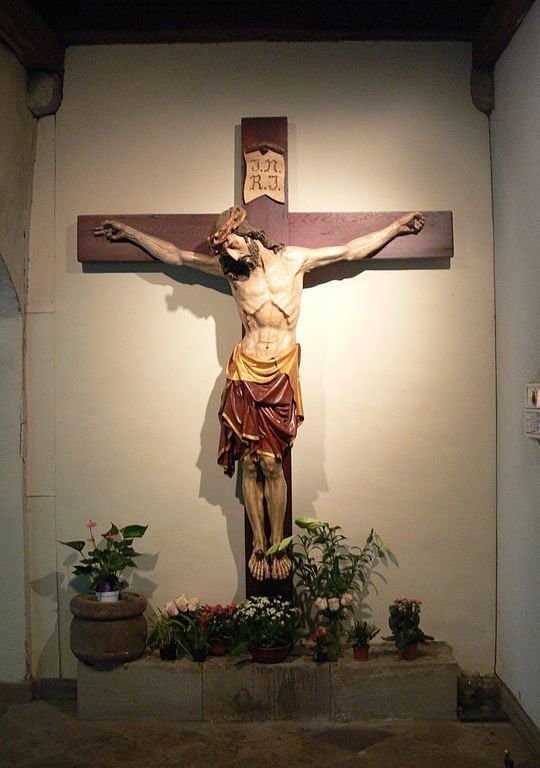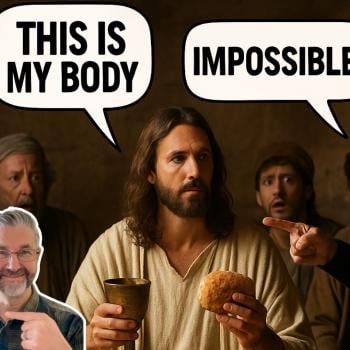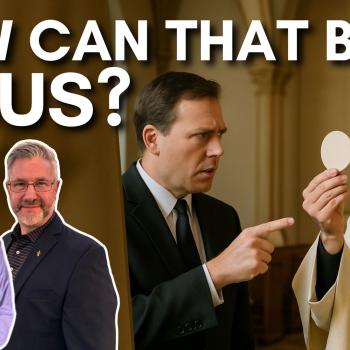Dialogue with a Calvinist

Cloisters of Essen Minster, Essen, Germany. Photo: Andreas Praefcke (June 2008) [released for public domain / Wikimedia Commons]
* * *
(11-10-09)
* * * * *
Calvinist preacher Charles Spurgeon wrote:
I. First, let us enquire, WHAT IS THIS CROSS OF CHRIST to which some men are sadly said to be enemies?
Of course, it is not the material cross. It is not anything made in the shape of the cross. There are some who can fall down and adore a cross of wood, or stone, or gold, but I cannot conceive of a greater wounding of the heart of Christ than to pay reverence to anything in the shape of a cross, or to bow before a crucifix! I think the Savior must say, “What? What? Am I the Son of God and do they make even Me into an idol? I who have died to redeem men from their idolatries, am I, Myself, taken and carved, and chiseled, and molten, and set up as an image to be worshipped by the sons of men?” When God says, “You shall not make unto you any graven image, or any likeness of anything that is in Heaven above, or that is in the earth beneath, or that is in the water under the earth: you shall not bow down yourself to them, nor serve them,” it is a strange fantasy of human guilt that men should say, “We will even take the image of the Son of God, or some ghastly counterfeit that purports to be His image, and will bow down and worship it, as if to make the Christ of God an accomplice in an act of rebellion against the commandment of the holy Law.” No, it is not the material cross to which Paul alludes—we have nothing to do with those outward symbols! We might have used them much more, but they have been so perverted to idolatry that some of us almost shudder at the very sight of them!
(Sermon #2553: The Enemies of the Cross of Christ; Metropolitan Tabernacle, Newington, 26 October 1884)
A guy who goes by “Dave” read the above started reiterating a case against crucifixes, and I defended them. Just as it was getting good, he split (why does that happen so often?! It frustrates me to no end). His words will be in blue.
* * * * *
I think that Miss Kelly Jay’s point clearly demonstrates the issue that I take concerning the crucifix, and why I agree with Spurgeon on this principle, which, for clarification, is not a material representation of something, but repetitive actions and intentions of people to create intrinsic meaning of an object apart from the real value of what that object symbolizes.
In her point, Miss Kelly Jay suggests that it should be obvious that, in order to obey the first commandment, and avoid having other gods before God, that we should make Jesus our idol. I can appreciate how she arrived to this. But the problem is that she is misinterpreting the meaning of the word “idol”, which is inherently something that is worshipped in Gods stead, that does not deserve the worship that God should be getting from us. God is not an “idol”. He cannot be because He is God (the three-in-one). And, if you really consider the commandment, it is that we should not have any other “gods” before God. That suggests that we are not to put “gods”, things that are lesser than God, which is ANYTHING (which is what an idol is, anything lesser than God that takes his place in someone’s heart and mind) in God’s place.
So, Miss Kelly Jay’s suggestion is actually not that we keep other things from getting our worship, and the #1 place in our heart and mind, but that we just make sure that we make God our idol.
This suggestion is inherently a misunderstanding of how we are to approach God, how we worship God, and why we worship God. Making sure that God is #1 is not enough, if we just think that He is simply the correct choice out of many choices of things we can choose. God must be #1 because of who He is and what He has done for us. And that knowledge, that truth is what causes us to realize that there is no contest, but simply an issue of whether we realize who is worthy of our worship, or if we give it to something else.
In short, we do not please God and obey his first commandment if we just make him our #1 idol. We must understand that He is not an idol. An idol is something made by God, or even worse, by human hands. God is God.
So, in answering Miss Kelly Jay, Jesus Christ can not be our idol, because he is not an idol. He is God. That is what should be obvious.
Also, a point should be made that Jesus did come down off the cross, eventually, and He rose again, which is very important, because it demonstrates his power over death and hell, and then he went to Heaven, which is also very crucial, because it demonstrates his authority. If He didn’t come down off the cross, we would be in a heap of trouble. Perhaps that is a major point of contention about the “crucifix”. A cross is a great reminder of what Jesus did for us, I agree. We must remember that Jesus died for us. But, he’s also gone ahead and done more afterward. That must also be remembered and understood and believed. We serve and believe in a risen Savior, who is alive in Heaven at the right hand of the Father.
Is this something that is clearly demonstrated by the crucifix? Or is this simply another tradition from “centuries of Christian practices”, as Erwin Fleischer stated, that comes between an individual and the simple, profound truth that is the entire work, the supremacy, and the SUFFICIENCY of Jesus Christ, and Him alone for our salvation?
Hi Dave,
Thanks for your comment.
Would it be okay, then, in your view, if, when there was a crucifix, it would always be required to have next to it an image also of the risen, glorified, ascended Jesus and a disclaimer under the crucifix:
“This is never intended to replace the real Jesus but only to represent Him, for the purpose of piously remembering and being grateful for what He did for us, and does not imply that Jesus did not rise again triumphantly”?
And with a disclaimer under the image of the risen Jesus:
“This is never intended to replace the real Jesus but only to represent Him, and does not imply that Jesus did not die on the cross for the redemption and salvation of the elect.” [?]
I’m not trying to be flippant or sarcastic; I’m perfectly serious. I’m trying to see what would be required for a proper use of a crucifix, from this “Spurgeonian” point of view, since there seems to be a very narrow window of acceptance for even Calvin and Spurgeon et al.
First, thanks for the replies. And, please understand that I did not write what I wrote to argue the inherent legitimacy of symbolism. I was simply blown away that Kelly Jay (with all respect) suggested that the purpose of the First Commandment was to make Jesus an idol. I come from the perspective/conviction that words have meaning. And this is no attempt to wax intelligent. I just wanted to see what you would say to her suggestion that Jesus was an idol.
And, DA, you seemed to agree with Kelly Jay on the point, and then Maureen suggested that Spurgeon’s whole point is based on optic stimuli, as if, anything that creates a physiological response is an idol, unless we’re having a “Paul on the road to Damascus” moment straight from Jesus. The reactions seemed a little far fetched, and I think it is because the definition of the word idol is either lost or misunderstood. And, if that’s true, then the whole point cannot be appreciated. Hence my comments about Spurgeon’s intentions so that the real issue could be considered.
Martin suggests that we don’t disagree; fantastic! That’s what I was interested in finding out. It seems that Kelly Jay may have misused a word, or expressed herself unclearly. But, the way I took it, she misses the serious reality of what an idol is. The definition of putting things before God, and what that entails. That’s a pretty important concept, and I just wanted to look further into her comment.
As for DA, I don’t imply that we be that absurd. And, I do take your comments seriously and genuinely. I understand your point. If, by my putting the issue of “idols” under a microscope (as I tend to do with the way I think through things) you got the impression that I was preoccupied with the details, correctness, and piety of every action of the church, no. As I suggested in my opening, it is the actions and intentions of Catholics in response to Catholicism that I was questioning. My concern is not what a symbol tangibly, literally communicates. That’s not the point of a symbol, because it’s symbolic. It represents something in simple form. My concern is what the average person’s perception and response is to the symbol, based on everything surrounding the symbol, in this case, everything that goes on within a Catholic church in regards to the crucifix.
So, if your answer is that you use it to further remind yourself of what Jesus did for us on the cross, and you also take careful, intentional measures to address his resurrection, then awesome! The gospel is preached. That was my concern and question, and this is the answer it seems that I’m getting.
To speak further on this, and respond to DA’s general question about the proper use of crucifixes, I think I would mainly point to the irony that what the crucifix symbolizes is the reason it could easily be considered unnecessary.
What Jesus Christ did on the cross for us broke the barrier between us and God. That was, interestingly enough, symbolized by the tearing of the divide in the temple to the Holy of Holies as Jesus died. He is our High Priest now, as we see in the NT, and we can go directly to Him. The HS also dwells within us (this all of course hinges on His grace through our faith in Him alone as our salvation) and so our connection with God now is inside us, and is entirely spiritual in its source.
So, if you step back and take a look at the OT and NT as a whole, you see a huge shift in the manner of our communication with God. In the OT, God is very outwardly symbolic. He demands sacrifices and lengthy, detailed rituals for many different things. He presents himself as many different outward things to demonstrate His presence. (Cue burning bush…) And people were just as symbolic and outward in return. This was the way God had it. Before, there was a required outward component for many things spiritual, and ultimately to have and sustain a relationship with God.
But now, the incredible truth is that God is now within us! And the emphasis shifts completely from outward to inward. We now facilitate our relationship with God from within, not from actions without. There are still things we do outwardly, but the inherent quality and significance of these things are completely reliant upon our personal, inward relationship with Jesus Christ, and are also a result, or outpouring of it.
So, I say all this to just give you the perspective of someone, like Spurgeon, who would see the crucifix and the other religious trappings and traditions of Catholicism as potentially superfluous, and approaching distractive or contraindicative. In other words, with all the outward stuff going on (symbols, etc) we lose sight of the meaning and importance and primacy of our inward focus.
Now, I say this with respect and love, and for the sake of the argument, and for a response. This is a touchy subject, and I have no mal-intent. So, what do you think? PS. Johnno, . . . I assume you’re drawing the emphasis of “preaching Christ crucified” which would legitimize the Catholic emphasis of the crucifix. If that is the case, then what is the Catholic take on “preaching Christ crucified”? What does that mean to me?
Hi Dave,
First of all, I agree that there was a bit of imprecision in the use of the word “idol” in Kelly Jay’s comment, but I think I know what she meant, so I was focusing on the overall intent, not particular definitions that could have been better expressed.
Folks can make an idol out of anything (as I think you’d readily agree): the Bible, their own spiritual pride, their office as a minister, riches, fame, power, beauty, you name it. So they can make an idol out of a crucifix if they choose to do so.
My argument is that since anything can be corrupted, this is not a sufficient argument to abolish things that can be corrupted, since in that case, everything would have to be abolished! It’s a reductio ad absurdum.
Calvinism and iconoclasm in general uses this sort of shoddy logic:
1) “so-and-so [in this case, a crucifix] can possibly become an idol.”
2a) “Because so-and-so [in this case, a crucifix] has the potential to become an idol, we ought to abolish it in order to remove all possibility of this happening.”
OR:
2b) “So-and-so [in this case, a crucifix] always, or almost always becomes idolatrous, therefore we should abolish it.”
Calvin and Spurgeon’s position seems to be 2b, but in my opinion it is a self-evidently ridiculous, ludicrous position.
Underlying the antipathy is the false notion (or at least a strong tendency to think) that images are wrong in and of themselves, and an over-broad, simplistic application of the prohibition of images in the Ten Commandments, that runs contrary to other scriptural indications.
I’m still not sure what you answer is to my query as to what would be acceptable. A simple “yes / agree” or “no / disagree” would suffice (no need for a theological / philosophical treatise).
DA, hey, thanks. That’s a perfect answer. And, I can appreciate that you were picking out her general point, which I also can see. That’s just what I was questioning, and your answer is very sound.
I really appreciate your perspective about eliminating everything out of the principle about idolatry. We can’t live in a bubble. I do however feel that there is a continuum to this principle, and finding a reasonable middle is prudent. You didn’t speak to this point, but I feel like you might agree. But, I guess I’m just also throwing out there the point that you can’t swing the opposite way and let everything go. There is a lot of Biblical precedent to this, as in cutting off your hand if it offends you because it’s better to get to heaven without a hand, etc. This is a very strong point about being guarded against temptation. I think Calvin and Spurgeon are just zealous about every-day idolatry. Perhaps, in your opinion, a little over-zealous. But, I don’t think their principle is entirely a “reduction of/to absurdity” as I assume you were saying. Many people have avoided much sin, pain and heartache from taking hard lines against the potential for temptation. To totally ignore the possibility is to invite it in.
As for the answer to your question, that’s exactly what I responded about. I feel like I addressed you directly, however diffuse it may have been.
You’ve got to be careful when asking someone to answer a question, but only a certain way. And, I’m not trying to get on my high horse here. I just felt like your question deserved more than a yes/no, even though I did actually say “no” to your question. “No”, as in, no it’s not ok to use symbols with clarifications on them, that’s absurd, just use the symbol, and try to intentionally use it appropriately.
That’s my answer, just as I put it. It points not to the symbol itself, but the use of it. Just go back and read my response, it’s right there. And, I don’t mean this to come off the wrong way, but, if there’s no need for my “theological/philosophical treatise”, then what’s this blog for? Kinda cutting me off at the knees with a “y/n” answer stipulation. . . .
I’m actually very interested in the Catholic perspective on these very issues. Sorry if I’m overstaying my welcome. Feel free to let me know if I am. This is just way easier than scheduling an appointment with a priest.
I’m still very interested in the response to my question to Johnno about what preaching Christ is in the Catholic perspective, and what Christ should mean to me.
Hi Dave,
Okay. I couldn’t tell from your earlier response what your answer would have been.
So your position (as I understand it) is that there is no possible way to correctly use a crucifix, even with provisions such as the ones I outlined.
What is your denominational affiliation, by the way, and do you think Catholicism is a species of Christianity and offers a saving gospel?
My concern is what the average person’s perception and response is to the symbol, based on everything surrounding the symbol, in this case, everything that goes on within a Catholic church in regards to the crucifix.
Exactly. This is precisely why I suggested a few provisions to offset possible idolatry by the tiny, misguided minority I believe is actually viewing a crucifix as a replacement for our Lord Jesus Christ Himself (i.e., as an idol and/or the proverbial “magic charm”).
Yet you don’t seem to think that is the solution to what you see as the problem. If there is a perception problem among Catholics on this score, then it could be solved by bringing to mind the things that Protestants want to be brought to mind (Jesus’ glorification and resurrection, etc.), no?
But you didn’t like my solution. So the only way is to get rid of crucifixes, because there is a danger that some will make them idols?
Very well. One could take that position, but in my opinion, closely scrutinized, it still reduces to absurdity, because then we would have to get rid of every potential idol, and that would include even the Bible itself. So we end up with a Bible-less Christianity based on the Bible (sola Scriptura), and that seems sensible?
If you disagree, then please show me how the Bible never becomes an idol for some people and is never exploited and distorted and twisted. Best wishes in that endeavor.













